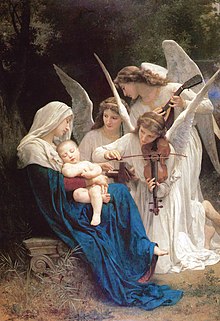It has been suggested that History of angels in art be merged into this article. (Discuss) Proposed since April 2024. |



Angels have appeared in works of art since early Christian art, and they have been a popular subject for Byzantine and European paintings and sculpture.
Normally given wings in art, angels are usually intended, in both Christian and Islamic art, to be beautiful, though several depictions go for more awe-inspiring or frightening attributes, notably in the depiction of the living creatures (which have bestial characteristics), ophanim (which are wheels) and cherubim (which have mosaic features);[1] As a matter of theology, they are spiritual beings who do not eat or excrete and are genderless. Many historical depictions of angels may appear to the modern eye to be gendered as either male or female by their dress or actions, but until the 19th century, even the most female looking will normally lack breasts, and the figures should normally be considered as genderless.[2][3] In 19th-century art, especially funerary art, this traditional convention is sometimes abandoned. The lack of gender was to enable these winged creatures to be relatable to both genders.
- ^ Wood, Alice. Of Wing and Wheels: A Synthetic Study of the Biblical Cherubim. pp. 2–4. ISBN 978-3-11-020528-2.
- ^ Daley, Michael J., ed. (2001). Catholic Questions, Wise Answers. Franciscan Media. p. 10. ISBN 0867163984.
Because angels are purely spiritual creatures without bodies, there is no sexual difference between them. There are no male or female angels; they are not distinguished by gender.
- ^ "Can Angels Be Male or Female?". Catholic Answers.
